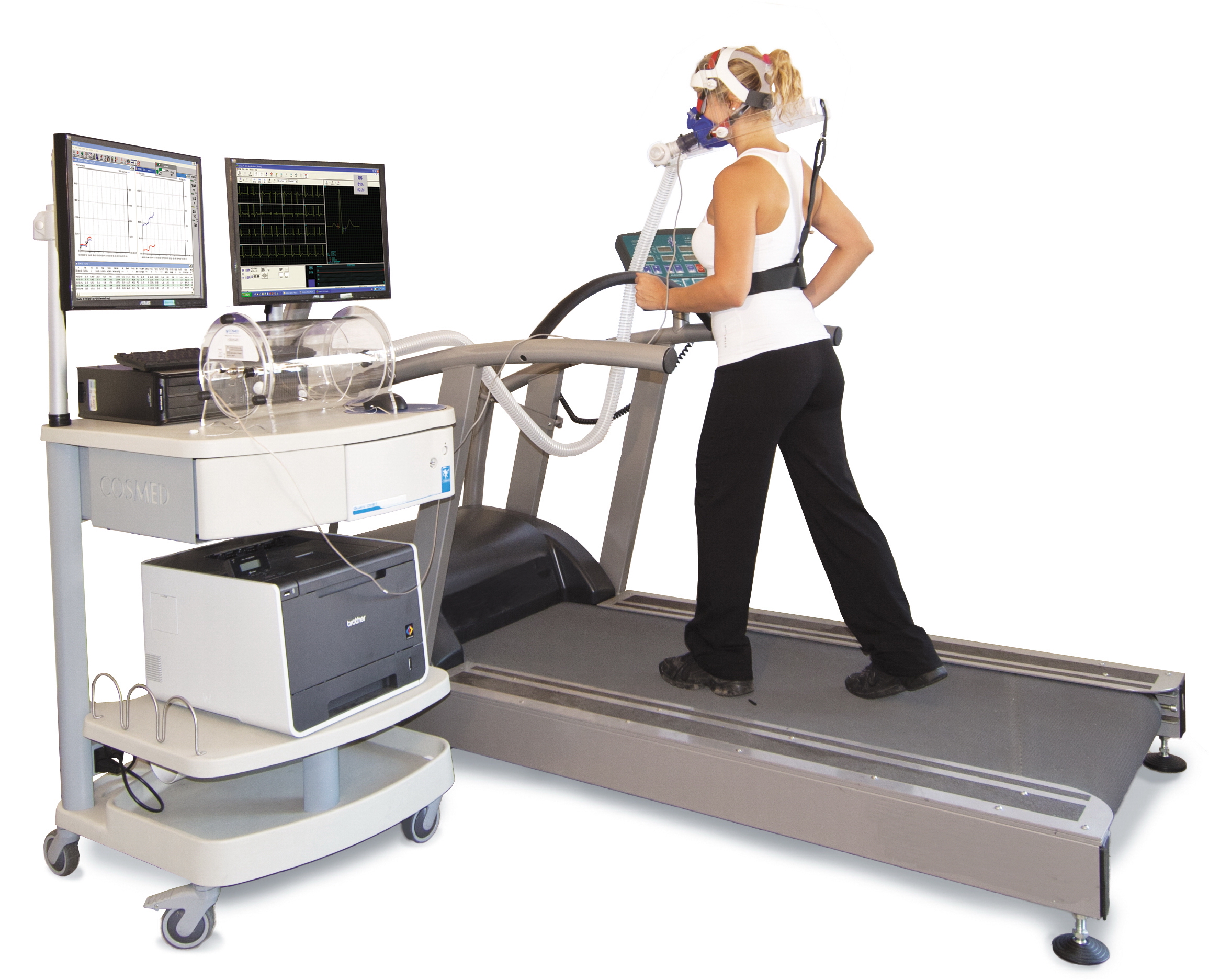|
Metabolic Equivalent
The metabolic equivalent of task (MET) is the objective measure of the ratio of the rate at which a person expends energy, relative to the mass of that person, while performing some specific physical activity compared to a reference, currently set by convention at an absolute 3.5 mL of oxygen per kg per minute, which is the energy expended when sitting quietly by a reference individual, chosen to be roughly representative of the general population, and thereby suited to epidemiological surveys. A Compendium of Physical Activities is available online, which provides MET values for hundreds of activities. A primary use of METs is to grade activity levels for common household activities (such as cleaning) and common exercise modalities (such as running). Vigorous household chores can add up to as much energy expenditure as dedicated exercise, so it is necessary to include both, suitably ''pro rata'', in an assessment of general fitness. An earlier convention defined the MET as a multi ... [...More Info...] [...Related Items...] OR: [Wikipedia] [Google] [Baidu] [Amazon] |
Energy
Energy () is the physical quantity, quantitative physical property, property that is transferred to a physical body, body or to a physical system, recognizable in the performance of Work (thermodynamics), work and in the form of heat and light. Energy is a Conservation law, conserved quantity—the law of conservation of energy states that energy can be Energy transformation, converted in form, but not created or destroyed. The unit of measurement for energy in the International System of Units (SI) is the joule (J). Forms of energy include the kinetic energy of a moving object, the potential energy stored by an object (for instance due to its position in a Classical field theory, field), the elastic energy stored in a solid object, chemical energy associated with chemical reactions, the radiant energy carried by electromagnetic radiation, the internal energy contained within a thermodynamic system, and rest energy associated with an object's rest mass. These are not mutual ... [...More Info...] [...Related Items...] OR: [Wikipedia] [Google] [Baidu] [Amazon] |
Aerobic Exercise
Aerobic exercise, also known as cardio, is physical exercise of low to high intensity that depends primarily on the aerobic energy-generating process. "Aerobic" is defined as "relating to, involving, or requiring oxygen", and refers to the use of oxygen to meet energy demands during exercise via aerobic metabolism adequately. Aerobic exercise is performed by repeating sequences of light-to-moderate intensity activities for extended periods of time. According to the World Health Organization, over 31% of adults and 80% of adolescents fail to maintain the recommended levels of physical activity. Examples of cardiovascular or aerobic exercise are medium- to long-distance running or jogging, swimming, cycling, stair climbing and walking. For reducing the risk of health issues, 2.5 hours of moderate-intensity aerobic exercise per week is recommended. At the same time, even doing an hour and a quarter (11 minutes/day) of exercise can reduce the risk of early death, cardiovascular di ... [...More Info...] [...Related Items...] OR: [Wikipedia] [Google] [Baidu] [Amazon] |
United States Department Of Health And Human Services
The United States Department of Health and Human Services (HHS) is a cabinet-level executive branch department of the US federal government created to protect the health of the US people and providing essential human services. Its motto is "Improving the health, safety, and well-being of America". Before the separate federal Department of Education was created in 1979, it was called the Department of Health, Education, and Welfare (HEW). HHS is administered by the secretary of health and human services, who is appointed by the president with the advice and consent of the United States Senate. The United States Public Health Service Commissioned Corps, the uniformed service of the PHS, is led by the surgeon general who is responsible for addressing matters concerning public health as authorized by the secretary or by the assistant secretary for health in addition to his or her primary mission of administering the Commissioned Corps. History Federal Security Agency ... [...More Info...] [...Related Items...] OR: [Wikipedia] [Google] [Baidu] [Amazon] |
VVO2max
vV̇O2max (velocity at maximal oxygen uptake), also known as maximal aerobic speed (MAS), is an intense running or swimming pace. This is the minimum speed for which the organism's maximal oxygen uptake (VO2 max) is reached, after a few minutes of constantly maintaining this exercise intensity. At higher paces, any additional increase in power is provided by anaerobic processes. In an incremental exercise test, it is the first speed at which any increase in exercise intensity fails to elicit an increase in oxygen consumption. The vV̇O2max of world class middle- and long-distance runners may exceed or 2:30/km pace ( or about 4:00/mile), making this speed slightly comparable to 3000 m race pace. For many athletes, vV̇O2max may be slightly slower than or mile race pace. Measuring vV̇O2max While a sophisticated lab may be required to obtain precise measures of vV̇O2max, it can be estimated using a simple field test on a 400 m running track. In a 2015 study of 28 male ... [...More Info...] [...Related Items...] OR: [Wikipedia] [Google] [Baidu] [Amazon] |
VO2 Max
V̇O2 max (also maximal oxygen consumption, maximal oxygen uptake or maximal aerobic capacity) is the maximum rate of respiration (physiology), oxygen consumption attainable during physical exertion. The name is derived from three abbreviations: "V̇" for volume (the dot over the V indicates "per unit of time" in Newton's notation), "O2" for oxygen, and "max" for maximum and usually normalized per kilogram of body mass. A similar measure is V̇O2 peak (peak oxygen consumption), which is the measurable value from a session of physical exercise, be it incremental or otherwise. It could match or underestimate the actual V̇O2 max. Confusion between the values in older and popular fitness literature is common. The capacity of the lung to exchange oxygen and carbon dioxide is constrained by the rate of blood#Oxygen transport, blood oxygen transport to active tissue. The measurement of V̇O2 max in the laboratory provides a quantitative value of endurance fitness for comparison of i ... [...More Info...] [...Related Items...] OR: [Wikipedia] [Google] [Baidu] [Amazon] |
Rating Of Perceived Exertion
In sports, health, and exercise testing, the rating of perceived exertion (RPE), as measured by the Borg rating of perceived exertion scale, is a quantitative measure of perceived exertion during physical activity. In medicine, this is used to document the patient's exertion during a test for the severity of diseases. Sports coaches use the scale to assess the intensity of training and competition as well as endurance. The original scale introduced by Gunnar Borg rated exertion on a scale of 6-20. Borg then constructed a newer category-ratio scale, the Borg CR-10 scale, rated on a scale from 1-10. This is especially used in clinical diagnosis and severity assessment of breathlessness and dyspnea, chest pain, angina and musculo-skeletal pain. The CR-10 scale is best suited when there is an overriding sensation arising either from a specific area of the body rather than overall exertion, for example, muscle pain, ache or fatigue in the quadriceps or from pulmonary responses during ... [...More Info...] [...Related Items...] OR: [Wikipedia] [Google] [Baidu] [Amazon] |
Calorimetry
In chemistry and thermodynamics, calorimetry () is the science or act of measuring changes in '' state variables'' of a body for the purpose of deriving the heat transfer associated with changes of its state due, for example, to chemical reactions, physical changes, or phase transitions under specified constraints. Calorimetry is performed with a calorimeter. Scottish physician and scientist Joseph Black, who was the first to recognize the distinction between heat and temperature, is said to be the founder of the science of calorimetry. Indirect calorimetry calculates heat that living organisms produce by measuring either their production of carbon dioxide and nitrogen waste (frequently ammonia in aquatic organisms, or urea in terrestrial ones), or from their consumption of oxygen. Lavoisier noted in 1780 that heat production can be predicted from oxygen consumption this way, using multiple regression. The dynamic energy budget theory explains why this procedure is corre ... [...More Info...] [...Related Items...] OR: [Wikipedia] [Google] [Baidu] [Amazon] |
Basal Metabolic Rate
Basal metabolic rate (BMR) is the rate of energy expenditure per unit time by endothermic animals at rest.. In other words it is the energy required by body organs to perform normal It is reported in energy units per unit time ranging from watt (joule/second) to ml O2/min or joule per hour per kg body mass J/(h·kg). Proper measurement requires a strict set of criteria to be met. These criteria include being in a physically and psychologically undisturbed state and being in a thermally neutral environment while in the post- absorptive state (i.e., not actively digesting food). In bradymetabolic animals, such as fish and reptiles, the equivalent term standard metabolic rate (SMR) applies. It follows the same criteria as BMR, but requires the documentation of the temperature at which the metabolic rate was measured. This makes BMR a variant of standard metabolic rate measurement that excludes the temperature data, a practice that has led to problems in defining "standard" rates o ... [...More Info...] [...Related Items...] OR: [Wikipedia] [Google] [Baidu] [Amazon] |
Anthropogenic Metabolism
Anthropogenic metabolism, also referred to as metabolism of the anthroposphere, is a term used in industrial ecology, material flow analysis, and waste management to describe the material and energy turnover of human society. It emerges from the application of systems thinking to the industrial and other man-made activities and it is a central concept of sustainable development. In modern societies, the bulk of anthropogenic (man-made) material flows is related to one of the following activities: sanitation, transportation, habitation, and communication, which were "of little metabolic significance in prehistoric times". Global man-made stocks of steel in buildings, infrastructure, and vehicles, for example, amount to about 25 Gigatonnes (more than three tonnes per person), a figure that is surpassed only by construction materials such as concrete. Sustainable development is closely linked to the design of a sustainable anthropogenic metabolism, which will entail substantial changes ... [...More Info...] [...Related Items...] OR: [Wikipedia] [Google] [Baidu] [Amazon] |
Surya Namaskar
Sun Salutation, also called Surya Namaskar or Salute to the Sun (, ), is a practice in yoga as exercise incorporating a flow sequence of some twelve linked asanas. The asana sequence was first recorded as yoga in the early 20th century, though similar exercises were in use in India before that, for example Indian wrestling, among wrestlers. The basic sequence involves moving from a standing position into Downward dog, Downward and Upward Dog poses and then back to the standing position, but many variations are possible. The set of 12 asanas is dedicated to the Hinduism, Hindu solar deity, Surya. In some Indian traditions, the positions are each associated with a different mantra, and with seed sounds or bīja. The precise origins of the Sun Salutation are uncertain, but the sequence was made popular in the early 20th century by Bhawanrao Shriniwasrao Pant Pratinidhi, the Rajah of Aundh State, Aundh, and adopted into yoga by Krishnamacharya in the Mysore Palace, where the Sun Salu ... [...More Info...] [...Related Items...] OR: [Wikipedia] [Google] [Baidu] [Amazon] |





